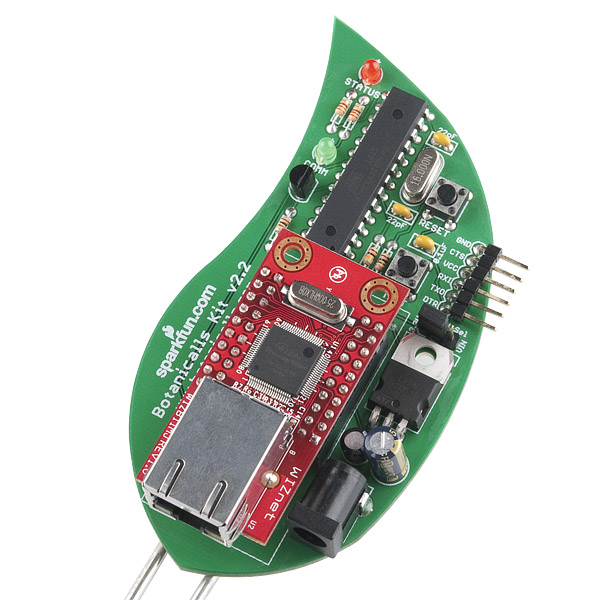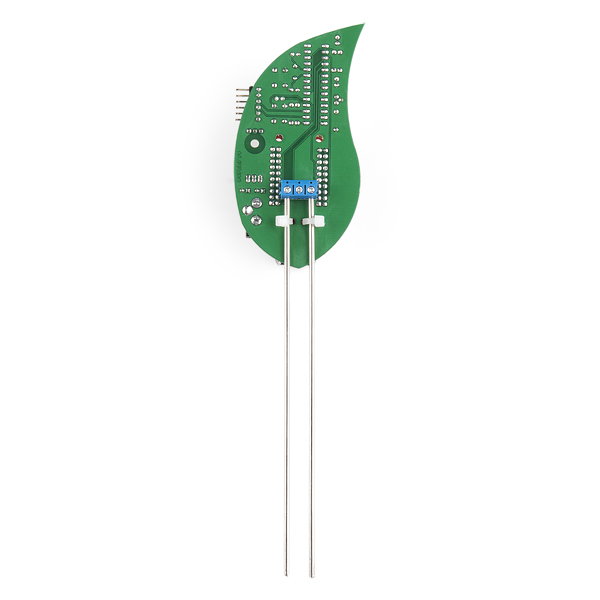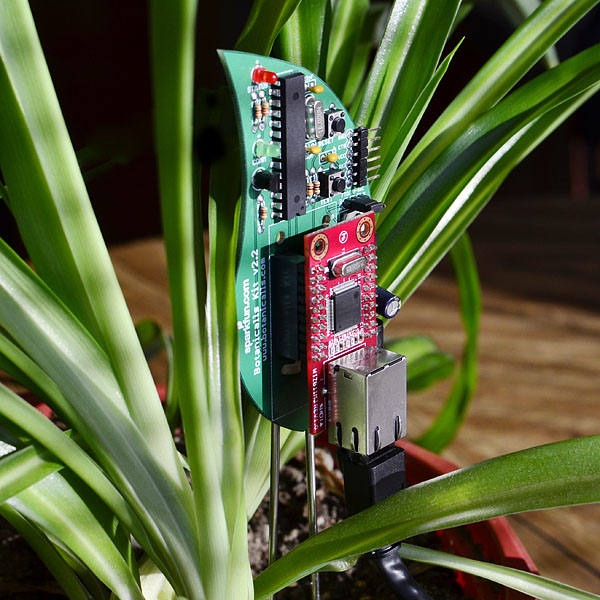Botanicalls Kit
Botanicalls Kits let plants reach out for human help! They offer a connection to your leafy pal via online Twitter status updates to your mobile phone. When your plant needs water, it will post to let you know, and send its thanks when you show it love. It comes as a kit so that you can hone your soldering skills (or teach someone else) while you build a line of communication between you and your houseplant!
This kit comes with everything you need to get your plant tweeting in no time. The ATmega328 comes pre-programmed, but you can customize it with your own messages. The only thing you need to provide is a plant, network connection (and ethernet cable), and a power outlet.
To upload custom code to the Botanicalls Kit, you'll need either an FTDI Cable or a 3.3V FTDI Basic Breakout.
See the link below for a step-by-step guide to assembling and customizing your Botanicalls kit.
Note: It's not shown in the parts photo, but the kit does include a 5V Wall Adapter.
Note: This product is a collaboration with Kate Hartman, Kati London and Rob Faludi. A portion of each sales goes back to them for product support and continued development.
Botanicalls Kit Product Help and Resources
Core Skill: Soldering
This skill defines how difficult the soldering is on a particular product. It might be a couple simple solder joints, or require special reflow tools.
Skill Level: Rookie - The number of pins increases, and you will have to determine polarity of components and some of the components might be a bit trickier or close together. You might need solder wick or flux.
See all skill levels
Core Skill: DIY
Whether it's for assembling a kit, hacking an enclosure, or creating your own parts; the DIY skill is all about knowing how to use tools and the techniques associated with them.
Skill Level: Noob - Basic assembly is required. You may need to provide your own basic tools like a screwdriver, hammer or scissors. Power tools or custom parts are not required. Instructions will be included and easy to follow. Sewing may be required, but only with included patterns.
See all skill levels
Core Skill: Electrical Prototyping
If it requires power, you need to know how much, what all the pins do, and how to hook it up. You may need to reference datasheets, schematics, and know the ins and outs of electronics.
Skill Level: Rookie - You may be required to know a bit more about the component, such as orientation, or how to hook it up, in addition to power requirements. You will need to understand polarized components.
See all skill levels
Comments
Looking for answers to technical questions?
We welcome your comments and suggestions below. However, if you are looking for solutions to technical questions please see our Technical Assistance page.
Customer Reviews
5 out of 5
Based on 2 ratings:
Great for teaching
I am using this kit as part of an introduction to agriculture technology unit. Students observe tweet frequency every week as the device moves from different soils. A great learning tool.






I find it funny all the people complaining of a lack of functionality- need more sensor ports, need wifi, need the Ethernet port facing a different direction. Please remember this is Spark Fun. I believe the point of these projects is to give you a place to start and "spark" all these ideas for YOU to to find solutions to. Then you post your solution here for others to learn from and explore. Have fun- prototype! Post! Open source solutions! Explore and learn about integration!
Now all you need to do is to remember to check on Twitter to see if your plant needs water..
I built something similar, but my project is actually watering the plant when it drops below the desired threshold. Maybe the next version of this pcb could have an io out so you could connect to an mosfet with a waterpump for watering as well.
It wouldn't be too helpful for someone like me who checks Twitter 3 or 4 times a month!
could you not swap out the ethernet port with an electric IMP? would that not allow it to connect to wifi? i dont know if that would work... im new, just starting out with all this stuff
I built something similar, but I'm monitoring 16 plants. And, instead of connecting to the internet, there's a blinky light in each plant to indicate that the soil is dry. There are 13 plants in my window though, which exceeded the port count of my Arduino, so I used a pair of shift registers for LED power, and a couple of 16-port multiplexers (one to power the probes, and one to do analog reads) so that I could hook 16 sensors to one arduino. I didn't hook it to the internet. The cost in Arduino parts was more like 25 dollars (a little over a dollar per plant) from Sparkfun. Admittedly, the wire running to each plant from the Arduino aren't the most beautiful thing in the world, but it does the job fairly well.
Are any extra pins broken out?
I think a simple drip irrigation system would be cheaper?
For me, building such a thing is fun but buying.... I'm not sure
Interesting idea...Has anyone come up with a similar kit that would monitor a hydroponics system like the Aerogarden from www.aerogrow.com yet?
It's funny you should mention aerogrow:
They're our neighbors :-)
I just put up some hanging baskets, is there an outdoor version in the works? (Tho' I could use up the left-over polyester resin and "pot" them. -G-)
eeerm... I have noticed a major flaw. What happens to the electronics when you spill water on them when wetting the plant.. Bzzzzzz fritz.
While we recommend keeping everything dry, I have accidentally splashed various incarnations of Botanicalls on various occasions without incident. Still, pouring water all over it on purpose is certainly best avoided.
Great idea - too expensive though, especially with no wifi so that multiple plants can be monitored. I will stick to checking the soil by hand for now.
Love the open sourceness to it all.. got the code up and running within 10 minutes using a 'Freetronics - Ethernet Shield With PoE' to test it. just need to build some probes.. agree it's pretty $$ for 1 plant, but maybe a xbee network will fix that..
I haven't understood yet how the board knows whether the plant needs water or not.
it measures the resistance between the two metal probes. the greater the resistance, the dryer the soil, and vice-versa.
This is pretty silly. There should be a design that allows multiple probes to be plugged into the main board. So, at the least, you could share the cost over multiple plants.
Also, it really is a bad idea to have power and water so close, especially with that cutesy, unpackaged circuit board. If that isn't obvious now, the first time you water the botanicalls instead of the plant, it will be...
By the way, the botanicalls forum seems to be broken - all the discussions point into outerspace...
Forums are fixed.
This seems like a great kit, but wouldn't it make more sense for the Ethernet port to be facing upwards? The current configuration seems to be difficult to plug a cable in.
lol no, if you stick the kit in the earth on the edge of the pot, you can plug it easily in from below. If you have to plug it in from the top, you will have a cable running through your (precious) plants. also, that will cause great tension on the whole kit by the hanging weight from the cable, potentially breaking/destroying the boards
What are the chances of making one of these that works with PoE?
Interesting timing - I just acquired a plant that needs watering at least once a day, and I am terrible at remembering to water the thing. So I was looking into some watering automation.
I'm guessing that the two metal bars are used to sense the presence / lack of water; for anyone that gets this, it might be useful to use a homemade sensor similar to http://www.cheapvegetablegardener.com/2009/03/how-to-make-cheap-soil-moisture-sensor.html instead of just the raw metal. Good luck to any and all other automated growers out there!
Hah, this is cute. But you must REALLY love you plant to lay out the cash for this. :P
I agree that this is expensive. Too bad they don't have one that uses the XBee network. I could see that being more helpful... And you could have MORE plants on the same network telling you when they need water. God!! Hook this up to your SparkFun Sprinkler timer network, and let your plant tell your timer how long to water. Add that cute little water valve, tee off a main water line, and you could let your plants water themselves. Just make sure that you have an over flow sense to let you know when the bottom of the plant is peeing so your timer knows when to shut off- and yes you’re going to have to have some catch basin to catch all the plant over flow water.
All controlled with a raspberry pi running a WebServer to manage from anywhere...
yes, I agree this is expensive, mostly due to the ethernet module. if sparkfun wanted to make this cheaper they could add a cheaper ethernet module or make it worth the money and add a wifi module.
(hint, hint)